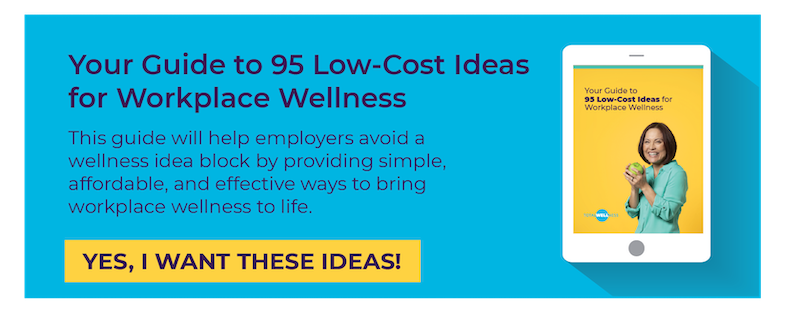 Employee wellbeing — how is it faring in most companies these days?
Employee wellbeing — how is it faring in most companies these days?
This won’t be a shocker for most: Employees are unhappy. As a result, their wellbeing is suffering, too. Overall, globally, unhappiness has been on the rise for the last decade.
Recent Gallup research found that emotionally, the second year of the pandemic was more draining than the first one. Stress, worry, and sadness plagued more people and set new records in 2021 for Gallup’s Negative Experience Index survey. Unfortunately, those negative feelings leak over into the work experience, too.
So what can you do to help improve employee wellbeing? Here’s a look at some simple ways to take charge of creating a healthier and happier workspace for your team:
1. Take a Whole-Person Approach
Employee wellness isn’t just about ensuring your workers are at a healthy weight and eating right. A successful approach to wellness in the workplace includes a whole-person approach.
A whole-person approach to employee wellbeing includes:
- Physical health
- Financial health
- Social health
- Mental health
That may look like creating a better work-life balance and developing a more robust supportive company culture. A whole-person approach in your wellness campaigns means not just focusing on physical fitness challenges or weight loss. But most employers with 10-plus employees don’t focus on a comprehensive workforce wellness program, according to a new 2022 report by the Returns on Wellbeing Institute. How can you redesign your programs to better serve your team members? When you do, you’ll find better engagement, lower turnover, and even less chronic illness. Work on a strategic plan with all leaders to create a comprehensive wellness approach.
2. Create a Collaborative Environment
A workplace that has a collaborative environment is far more enjoyable than one where workers are pitted against one another. Employees who accept one another create a successful collaborative environment. Opportunities to collaborate give employees a sense of belonging, which can lead to more happiness at work.
3. Work Smart Together
Successful teams work smarter, not harder. Healthy work habits can contribute to an overall more productive workforce, which is why focusing on this element is essential for employee wellbeing. Emphasize healthy productivity in order to increase employee satisfaction and prevent burnout. It takes regular feedback from workers and ongoing assessments from leadership to create the most efficient teams.
A few ways to do it:
- Get honest feedback regularly
- Host lunch and learns about relevant health topics
- Talk about workloads and adjust as necessary
- Do quarterly ergonomic assessments to ensure healthy workspaces
Take regular assessments of your current work environment for insight as to where workers may need a little extra support. Get feedback and make changes as necessary.
4. Keep a Full Staff
There’s nothing more stressful than having a bare-bones staff. While it sometimes can’t be helped, it’s important to note when employees ask for more backup help. If there’s a common thread of needing more help with multiple departments from various employees, chances are the workload is too much. Leave your employees without the proper support and they’ll get burned out and look for work elsewhere.
5. Develop Stable Schedules
Routines are a good thing. This is especially true for working parents or those with busy lives outside the workplace. In fact, a stable schedule is important for workers’ health and wellbeing.
For those who deal with regular on-call schedules, it can cause:
- Poor sleep quality
- Overall unhappiness
- Psychological distress
The Shift Project’s survey found that half of service sector workers reported a “moderate amount of psychological distress” including hopelessness, nervousness, depression, and more. Regulate schedules, raise pay — or do both — to have a positive impact on employee wellbeing.
6. Offer Personal Development
Personal development is an excellent opportunity for employees to improve their potential, talent, and even wealth. It’s a lifelong process that doesn’t end with a course, book, or lecture. It’s an ongoing opportunity that can increase self-awareness and allow your team members to improve themselves. Regularly offering personal development workshops, lectures, book clubs, etc. can help your workers to cultivate areas of themselves that improve their wellbeing and also help them to excel in the workplace.
7. Come Together
Social wellbeing is an essential part of mental health. Keeping social ties and connections is a key part of how individuals can have a fulfilling and productive life.
Socially healthy employees are:
- Less stressed
- More productive
- Healthier overall
- Serve their company better
- More creative and resilient
- Have more self-confidence
There’s a major correlation between good social health and overall wellbeing. Give your workers a chance to connect for coffee, lunchtime breaks, after-hour events, and on projects as often as possible. Equally as important is allowing employees time off to reconnect with friends and family when they aren’t working, too.
RELATED: What is Social Health? A Pillar of Wellness Workers Need Now
8. Make Mental Health a Priority
With the rise of mental health challenges since the pandemic began, employers are realizing the importance of workers taking care of their mental health. Take a look at ways you can help minimize the stigma of discussing mental health in the workplace. Consider ways to make it the focus of your wellness campaigns so people are more open to talking about it. SAP, a multinational software company, incorporates a Global Mindfulness Practice to help employees deal with everyday stress. The company — which has over 100,000 employees globally — also has a program called “Are you OK?” to tackle mental health stigmas.
9. Have Empathy
Empathy can be good for you and those around you. As an employer, being empathetic can increase loyalty among your workers. An attitude of empathy can also promote good health and lower stress in the workplace, according to a 2018 article by Psychology Today. Perhaps best of all is that in an era of many individuals quitting, practicing empathy often in the workplace can lower the burnout rate.
Ways empathy helps:
- Lowers stress
- Guides morals
- Connects you to others
Consider having a lunch and learn event to invite a psychologist in to discuss the health benefits of practicing empathy. Not only can it improve employee wellbeing by teaching workers to be kinder and more patient with others, but it can also help the workplace become a safer, more enjoyable environment.
Employee Wellbeing at Work Matters
There’s no denying that when workers are well, they do their best. The responsibility of a healthy workplace ultimately falls on employers to provide employees with the necessary support. That includes initiatives like the ones above, including stable schedules, mental health resources, and social connectedness.
Employee wellbeing is the core of a solid, successful company and organization. Taking a proactive instead of reactive approach can create the best possible environment for all workers to thrive. Studies show the happier workers are, the more productive they are, which leads to improved morale as well.
Starting today, look at ways you can better serve your employees when it comes to mental, physical, financial, and emotional wellbeing. Many factors contribute to your workers’ wellbeing; asking for their input on a regular basis and implementing initiatives often can make all the difference when it comes to a healthy workforce and one that’s unwell.
Like this post? Then you’ll love The 7 Workplace Distractions That Are Unhealthy for Employees.



